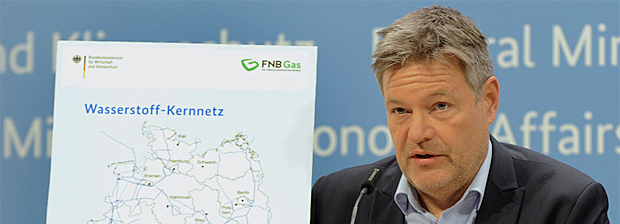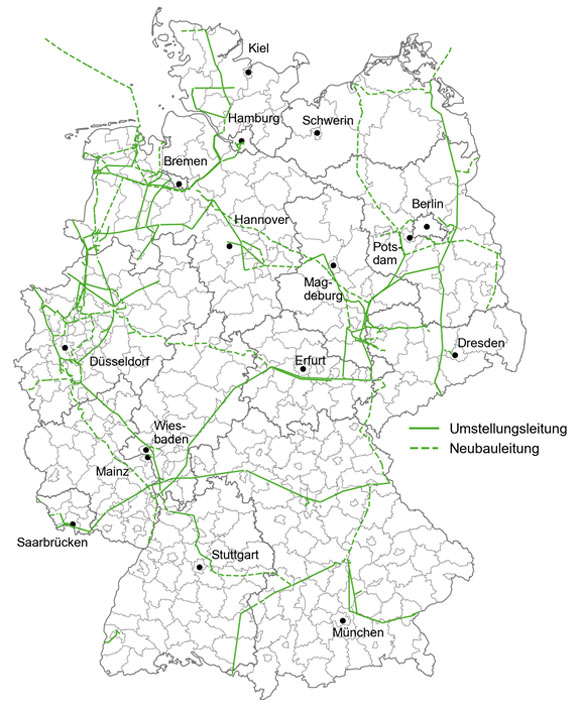Germany pressing ahead with the building of a core hydrogen network
Hydrogen is considered to be crucial for a future climate-neutral energy supply. In the last few weeks, key policies have been put in place for the creation of a 9,700 kilometre long core hydrogen network in Germany.
 © BMWK
© BMWK
As a fuel of the future, it is to be used to operate power stations and blast furnaces in a climate-friendly way. Green hydrogen is regarded as a key element for the future decarbonisation of energy-intensive and non-electrifiable branches of industry. In future, it will flow through Germany in a 9,700 kilometre long transport network. Between 2025 and 2032, the hydrogen pipelines are to gradually come on stream. 60% of the network can consist of existing natural gas pipelines that have been converted to hydrogen.
This is already the case in Bad Lauchstädt EnergiePark in Saxony-Anhalt. This is the site of Germany’s first hydrogen pipeline, which is testing and using all the elements of the hydrogen infrastructure chain – such as generation, storage, transport and use. To this end, the people in Bad Lauchstädt are converting existing natural gas pipelines from the 1970s to supply the nearby Leuna Chemical Park with green hydrogen.
Security of the natural gas supply must remain in place
On 15 November 2023, the federal cabinet adopted the statutory framework for an integrated Network Development Plan for Hydrogen and Gas and the financing of the core network (in German only). In parallel to this, the gas transmission system operators (the future hydrogen grid operators) published their draft application for the design of such a core network. It shows the basic structure for the hydrogen infrastructure which will connect the main hydrogen sites in Germany, e.g. large industrial centres, storage facilities, power stations and import corridors.
As the core network is planned and implemented, it will be important to maintain the security of the natural gas supply at all times. The switch to hydrogen must not result in any bottlenecks in the gas supply. Ultimately, the feed-in capacity of the core network is to be 100 gigawatts, and the take-off capacity 87 gigawatts. This means that the core network will be well positioned to cope with the expected demand. In 2032, the core network will be ready for a take-off capacity of around 280 terawatt hours. To put this figure into perspective: the National Hydrogen Strategy currently assumes a need for 95 to 130 terawatt hours of hydrogen in 2030.
 © FNB Gas e.V. - Draft core hydrogen network (as of 15 November 2023)zoom
© FNB Gas e.V. - Draft core hydrogen network (as of 15 November 2023)zoomCore hydrogen network is to form a nationwide backbone
It is important to note that the core network will primarily serve the supra-regional transport of hydrogen and form a nationwide backbone. So it is only the first phase of the network rollout. In subsequent development steps, further regions and sites are to be connected, and the network is to be optimised and expanded in line with needs. To this end, an integrated Network Development Plan for Gas and Hydrogen will be produced every two years on the basis of scenario- and needs-based planning. Working from this, it will be possible for other hydrogen consumers, producers and storage facilities to be connected to a nationwide network.
Despite having its own hydrogen infrastructure, Germany will need to cover a large proportion of the hydrogen it requires (around 50-70% in 2030) by imports. To this end, the core hydrogen network is to be integrated into the European hydrogen network, and cooperation is to take place with other EU Member States. This should lead to a coordinated European hydrogen rollout with common standards and coordinated imports.
Further information
- FAQs from the Federal Ministry for Economic Affairs and Climate Action on the core hydrogen network (in German only)
- Information from FNB Gas about the core hydrogen network
- Information from the Bundesnetzagentur on the consultations on the core hydrogen network (in German only)
- Press conference of the Federal Ministry for Economic Affairs and Climate Action on the core hydrogen network (in German only)
- Press release by the Federal Ministry for Economic Affairs and Climate Action: “Act on Hydrogen Grid Planning and Core Grid Financing adopted” (in German only)

